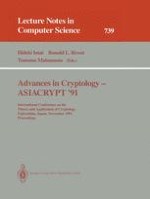This volume contains the proceedings of ASIACRYPT '91, the first international conference on the theory and application of cryptology to be held in the Asian area. It was held at Fujiyoshida, near Mount Fuji in Japan, in November 1991. The conference was modeled after the very successful CRYTO and EUROCRYPT series of conferences sponsored by the International Association for Cryptologic Research (IACR). The IACR and the Institute of Electronics, Information and Communication Engineers were sponsors for ASIACRYPT '91. The papers from the conference were improved and corrected for inclusion in this volume. The papers are grouped into parts on: differential cryptanalysis and DES-like cryptosystems; hashing and signature schemes; secret sharing, threshold, and authenticationcodes; block ciphers - foundations and analysis; cryptanalysis and new ciphers; proof systems and interactive protocols; public key ciphers - foundations and analysis. Also included are four invited lectures and impromptu talks from the rump session.
